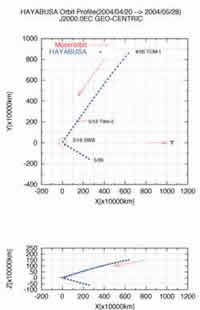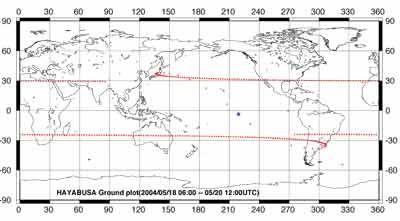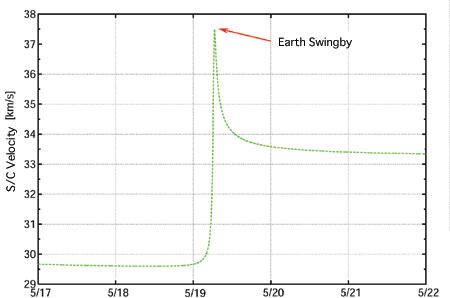TOP > Topics > 2004 > Current Status and Future Plan of HAYABUSA
![]()
Current Status and Future Plan of HAYABUSA

HAYABUSA has now succeeded in Earth swingby operation May 19, for getting to its final destination, the asteroid “Itokawa”. After its launch on May 9, 2003, HAYABUSA has been accumulating orbital energy by ion engine thrust as flying almost the same size orbit as the earth’s orbit around the sun. When closing to the earth on May 19, 2004, about a year after launch, HAYABUSA made further acceleration, together with its saved energy, by the earth’s gravity it received then, and directed its course toward Itokawa. By using gravity, a natural force, it could attain at a time acceleration equivalent to 4km per second without consuming its propellant. It skimmed 3,700km over the Eastern Pacific Ocean at its closest distance to the earth.
Changing orbit as planned of spacecraft by the swingby requires extremely precise orbit adjustment. As for HAYABUSA, adjustment was made that it would pass a pre-determined position nearby the earth within 1km in position error and 1cm/s in velocity error, approaching from the position, 15 million km away.
As you know, HAYABUSA has cruised by continuous acceleration by ion engine thrust. But, its ion engine operation was stopped on March 31 in order to set accurately its trajectory hereafter. Its chemical rocket (not ion engine), which can provide larger momentary power, was operated in order to tune precisely its orbit.
At the swingby, HAYABUSA passed through the night side of the earth. It will, accordingly underwent “shade area” for nearly 30 minutes. While flying in the interplanetary space, HAYABUSA always generates electric power by its solar cells to supply the needed energy since there is no barrier between the Sun and HAYABUSA. On passing through the earth this timr, it waz first operated only with its onboard batteries. We are preparing the operation only by the batteries.
|
HAYABUSA carries a total of three cameras for optical navigation and observation of the asteroid Itokawa. We took pictures of the earth and Moon by the cameras when passing nearby the earth, together with testing their performance. Observation of the earth and Moon with the onboard Near Infrared Spectrometer (NIRS) also was done. We obtained beautiful and dynamic photos of the coming-up earth was taken.
|
May 25, 2004







